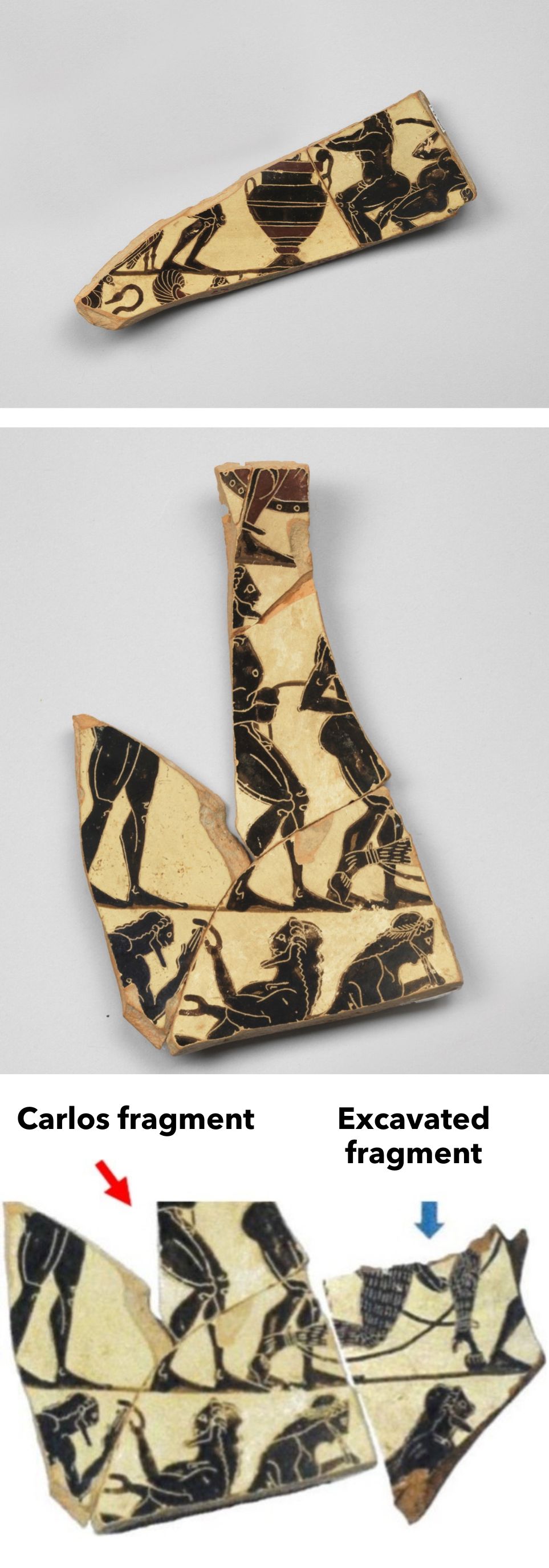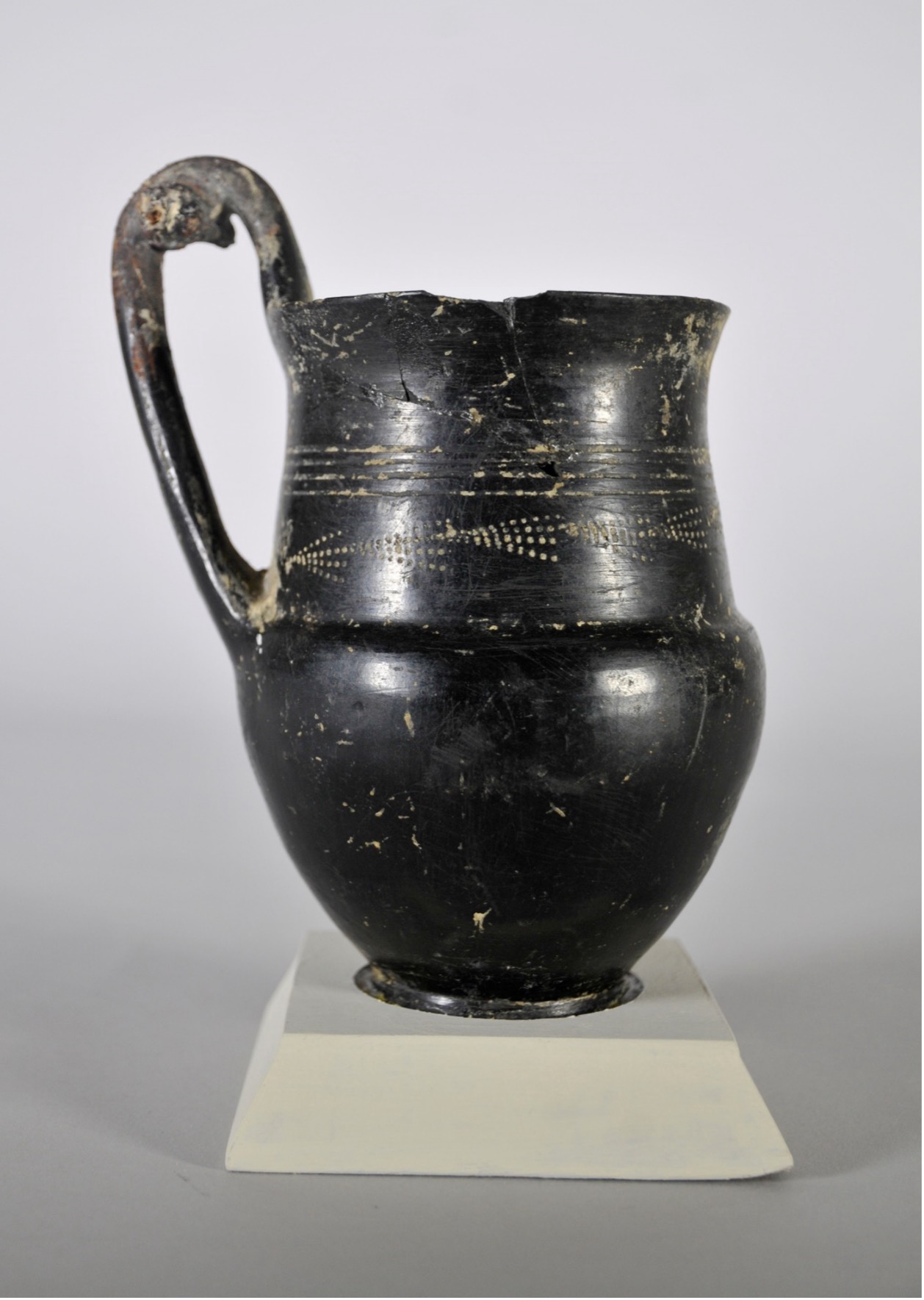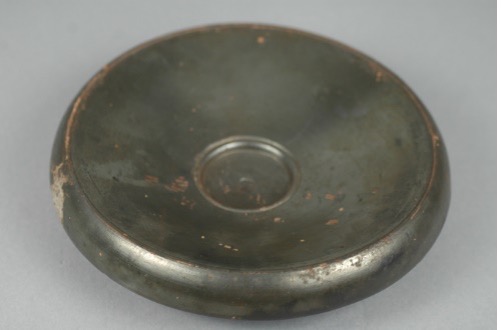Five Fragments from a Laconian Cup

On December 20, 2024, title for a group of fragments from a Laconian black-figure cup (L2024.052.003A and B, formerly 2006.042.001A and B) was transferred to Italy by the Michael C. Carlos Museum after evidence showed they join a fragment discovered through controlled archaeological excavation in Italy.
Acquisition Background
The Carlos acquired the fragments from the scholar Dietrich von Bothmer in 2006. According to notes written on the sherds, von Bothmer acquired them from archaeologists Hans and Ines Jucker of Bern, Switzerland in 1985.
Investigative Research
In February 2024, Italy’s Ministry of Culture presented the Carlos with photographic and documentary evidence compiled by the Carabinieri Command of Cultural Heritage Protection and archaeologists from the Timpone della Motta in Francavilla Marittima (Cosenza). In 2022, archaeologists discovered a Laconian cup fragment within a pit made by looters. The excavated fragment matches exactly with the fragments donated to the Carlos by von Bothmer. Excavators also found three Fanta drink cans from the 1970s, suggesting the Carlos fragment was likely looted around this time.
Decision
Reuniting the cup fragments was a priority for both the Carlos Museum and the Italian Ministry of Culture. Title for the fragments has been transferred to the Republic of Italy, and the objects remain on loan to the Carlos where they will be used in an exhibition educating people about the impact of looting at Francavilla Marittima.
Featured Images
(Top) Black-Figure Cup Fragment. Greek, Laconian. Archaic, ca. 560 BCE. Ceramic. Loaned by the Italian Republic/Concesso in prestito dalla Repubblica Italiana. L2024.052.003A.
(Middle) Black-Figure Cup Fragment. Greek, Laconian. Archaic, ca. 560 BCE. Ceramic. Loaned by the Italian Republic/Concesso in prestito dalla Repubblica Italiana. L2024.052.003B.
(Bottom) Reconstruction image showing joins. Photograph provided by the Italian Ministry of Culture.
Bucchero Jug

On December 20, 2024, the Michael C. Carlos Museum transferred title for an Etruscan vessel (L2024.052.001, formerly 2004.040.001) to Italy after the Carlos presented Italy’s Ministry of Culture with evidence the vessel was likely illegally excavated.
Acquisition Background
In 2004, the jug was acquired as a gift from a private collector who had inherited the vessel from a family member. The family member had received the jug from an Italian family.
Investigative Research
In November 2023, the Carlos Museum provided the Italian Ministry of Culture with a statement provided by the donors that the jug was discovered through probing an Etruscan mound with fiberoptic technology. As fiberoptic technology did not become widespread until the 1970s and 1980s, the Carlos felt there was a high likelihood the mound was explored during an unauthorized excavation in modern times.
Decision
To demonstrate our commitment to the Cultural Cooperation Agreement signed by both parties, the Carlos Museum has transferred title of the Bucchero jug to the Republic of Italy. The vessel remains on long term loan to the museum.
Fish Plate

On December 20, 2024, the Michael C. Carlos Museum transferred title for a fish plate (L2024.052.002, formerly 2004.040.002) to Italy after the Carlos provided Italy’s Ministry of Culture with evidence the vessel was likely illegally excavated.
Acquisition Background
In 2004, the fish plate was acquired as a gift from a private collector who had inherited the vessel from a family member. The family member had received the jug from an Italian family.
Investigative Research
In November 2023, the Carlos Museum provided the Italian Ministry of Culture with a statement provided by the donors that the fish plate was discovered through probing an Etruscan mound with fiberoptic technology. As fiberoptic technology did not become widespread until the 1970s and 1980s, the Carlos felt there was a high likelihood the mound was explored during an unauthorized excavation in modern times.
Decision
To demonstrate our commitment to the Cultural Cooperation Agreement signed by both parties, the Carlos Museum has transferred title of the fish plate to the Republic of Italy. The vessel remains on long term loan to the museum.




